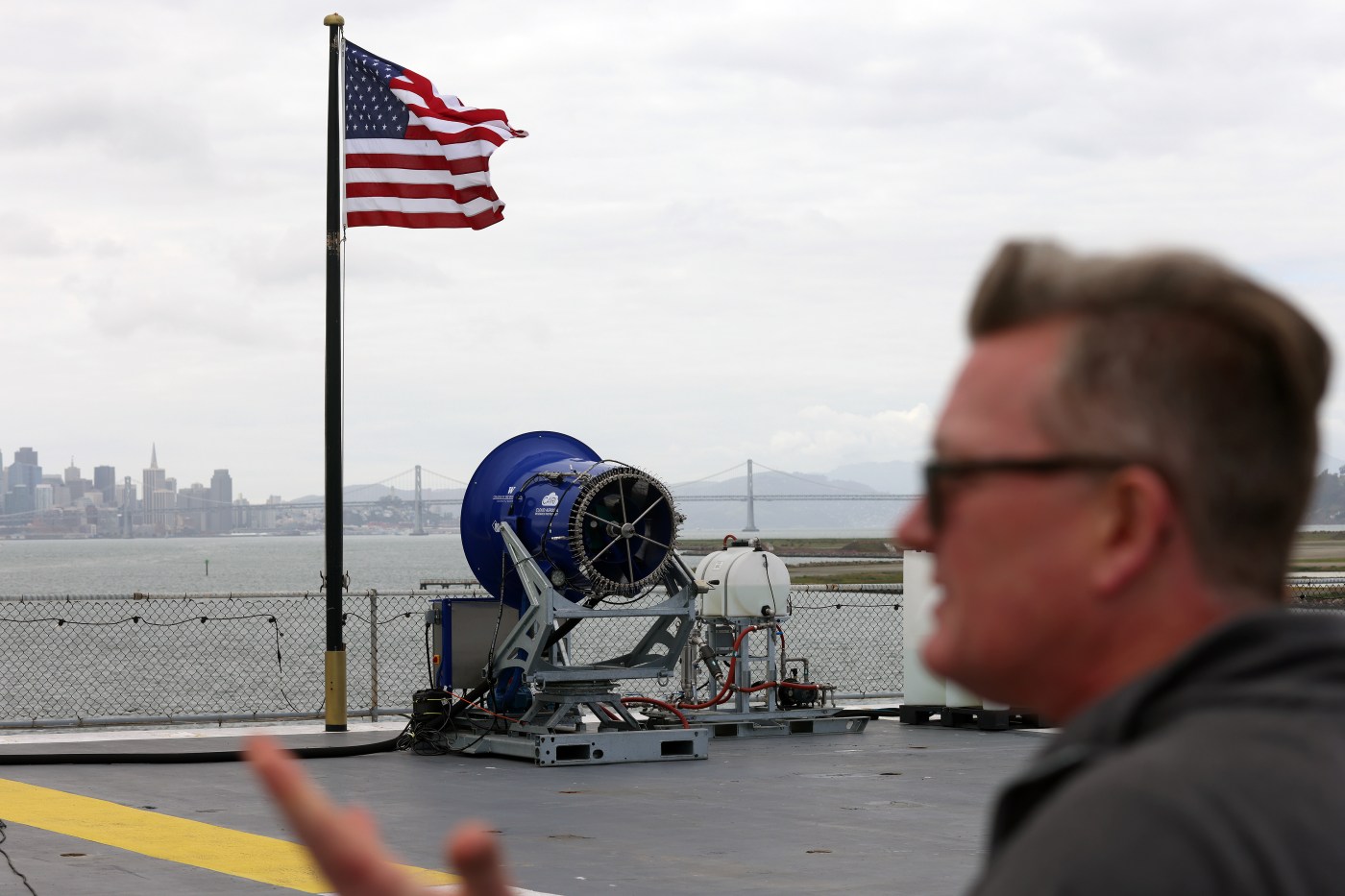The flight deck of a decommissioned World War II-era aircraft carrier docked at Alameda has recently begun launching something other than airplanes: microscopic droplets of salt water that scientists hope will help counteract the effects of climate change.
A team of atmospheric scientists from the University of Washington has teamed up with Silicon Valley-based Stanford Research Institute, an independent nonprofit research facility, and SilverLining, a nonprofit focused on near-term climate risks, to study whether adding plumes of salt water to a cloud will make it more reflective and stop excess heat from reaching the Earth’s surface.
Cloud brightening is an idea first proposed by British scientist John Latham in 1990. Now after years of discussion and experiments, the University of Washington’s privately funded attempt to put Latham’s idea to the test is ready for trials outside of a lab.
The Marine Cloud Brightening Program has taken up residence on the USS Hornet, where scientists will spend the next several months testing equipment and creating computer models to find out if their lab results can be replicated in real atmospheric conditions. At the program’s official launch on Wednesday, scientists from around the world gathered to discuss the new technology and see the testing setup.
“This project is a really unique collaboration,” said Kelly Wanser, the executive director of SilverLining, during the program’s launch event.
The Hornet, an 80-year-old aircraft carrier turned museum, was chosen as the home for the tests. Wanser said she was “blown away by the combination of science, history, engineering [and] human innovation” at the ship.
Cloud Aerosol Research Instrument on the flight deck of the USS Hornet Museum on Wednesday, April 24, 2024, in Alameda, Calif (Aric Crabb/Bay Area News Group)
The Hornet was built during World War II and went on to fight through the Cold War and Vietnam War, said the Hornet’s marketing manager Russell Moore. Its final mission was retrieving the astronauts from the Apollo 11 and 12 missions after they landed in the Pacific Ocean. The Hornet was decommissioned following the Apollo mission, and was scheduled to be scrapped. Instead, the ship was given a second life as a museum, and now serving as the home for this experiment is a new chapter in its storied history.
Scientists at the University of Washington have already gone through about 70 iterations of the technology in the laboratory, said Dr. Rob Wood, principle investigator and professor of atmospheric science at the University of Washington. Now, they are using the experiment on the Hornet to move to the next step of research: testing the sea salt plumes in real clouds.
After being launched from nozzles in a spinning, fan-like machine, the spray of salt water—in which the droplets are broken down into tiny molecules only 1/1000th the width of a human hair — diffuses through the air and into the clouds, where it replicates the reflective effect of natural aerosols. Scientists theorize that with this increased reflectivity, clouds can block excess heat from making it to Earth’s surface and contributing to global warming.
Wood explained there are a number of questions about the real-world effectiveness of the technology that they are attempting to answer with this experiment.
“Even if we could make the particles go into the clouds, how much do they brighten the clouds?” he said. “Can we even make the particles that we think are sufficient to brighten the clouds?”
Related Articles
Letters: Recall a waste | Eliminating plastics | Student protesters | Fund diplomacy
San Mateo County approves $15 million budget for drainage project
Climate change supercharged a heat dome, intensifying 2021 fire season, study finds
Firefighter, forester, trail builder: The first US Climate Corps jobs are here
When red-hot isn’t enough: New government heat risk tool sets magenta as most dangerous level
Scientists plan to launch the molecules over open ocean, and working on the Hornet — specifically in the morning — allows them to match those atmospheric conditions, such as 70-80% humidity, Wood said. Higher humidity makes it more likely the salt water droplets will remain in liquid form instead of drying into salt crystals, which may interact differently with each other, he added.
“Every few minutes is different,” Wood said of the weather and wind conditions. “It’s moving everything around, and that will hopefully dilute the plume so that the particles are further apart and they don’t really interact with each other.”
The project launch also included a screening of a Ted Talk by Dr. Sarah Doherty, the project’s program director, where she explained the science behind the experiment.
“This is not a solution to the climate crisis,” she said. “However, marine cloud brightening might be a way of treating the main symptom of the problem, which is too much heat in the atmosphere and ocean.”
Wood acknowledged that there are some people who question whether there will be unintended consequences of implementing cloud brightening, and added that there are already studies at other universities studying potential consequences, such as those on marine ecosystems.
“It’s a big effort beyond this small part of it that we’re doing,” Wood said. “It’s always going to be a comparison, ultimately, with what would happen if we didn’t do anything — if we just left climate change unchecked.”












